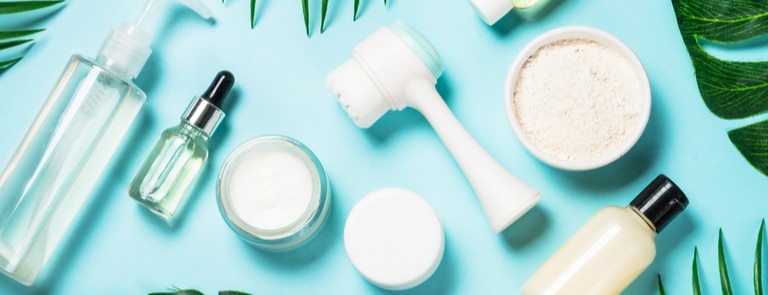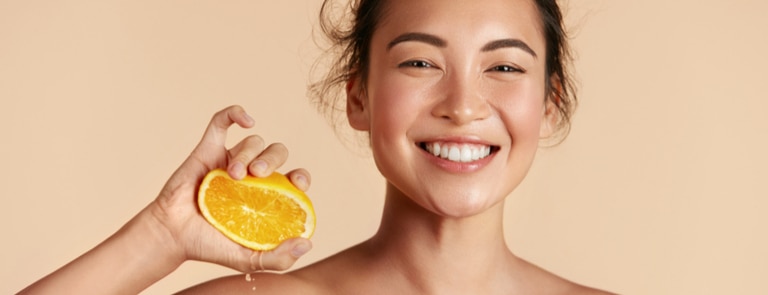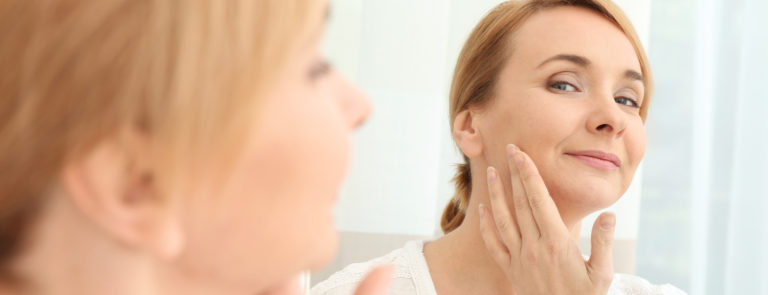15% off €35 OR 20% off €45
8 of the best skincare ingredients to add to your routine

When it comes to skincare, it can take you right back to being a kid in a sweet shop. Retinols, acids, collagen, oils, the range of skincare ingredients and products available is so vast, it’s enough to make you feel giddy.
But it’s a good kind of giddy, because there’s nothing better than discovering and then trying a new skincare ingredient that works wonders for your skin. But where to start – do you try something new based on what you need for your skin or do you go with the product that popped up on your social feeds with rave reviews, or the beauty buy your friend recommended to you the other day?
Panic not. We’ve delved deep into that extensive ingredients list and explained all you need to know about the best skincare ingredients below.
Skincare ingredient 1: Vitamin C
Why is Vitamin C good for skin?
Vitamin C promotes collagen production, which can help to reduce the appearance of fine lines and wrinkles. It also evens out skin tone in the process. A powerful antioxidant, Vitamin C protects from free radical activity caused by UV exposure.1
Read more: 10 reasons why we love Vitamin C for skin
How to use it: In the morning after cleansing and before applying moisturiser and SPF.
Skincare ingredient 2: Vitamin E
Why is Vitamin E good for skin?
Vitamin E can work wonders for moisturising dry skin, helping even out skin tone and making skin look younger. Like Vitamin C, Vitamin E is an antioxidant and can improve the appearance of skin by helping it to look firmer and fuller.2 Meanwhile, Vitamin E oil in particular acts as an emollient, pulling dirt out of clogged pores and leaving skin feeling cleaner and looking fresher overall.3
How to use it: Morning or night, but apply at night-time and keep on overnight if your skin is particularly dry.
Skincare ingredient 3: Retinol
Why is retinol good for skin?
A fat-soluble derivative of Vitamin A, retinol is widely associated with being a reliable anti-aging ingredient that’s available over the counter. As for what it can do for skin – it helps protect against wrinkle formation.4
How to use it: Once a day, ideally just before you go to bed. Build up to using it every single day; you need to give your skin a chance to get used to it.
Read more about how retinol works here: 'What is retinol and how to use it'.
Skin ingredient 4: Castor oil
Why is castor oil good for skin?
Castor oil is credited with helping prevent the appearance of wrinkles, because of its ability to penetrate the skin, leaving it feeling refreshed and soft. It's also naturally rich in cleansing ricinoleic acid, helping to hydrate skin. This makes it suitable for sensitive skin prone to conditions such as eczema and psoriasis.
How to use it: Apply to clean, dry skin once or twice a day, or as needed.
Skin ingredient 5: Tea tree oil
Why is tea tree oil good for skin?
Tea tree oil has natural cleansing and purifying qualities. And, as a result of this, it can help reduce skin redness and hydrate skin.6
How to use it: Apply to clean, dry skin once or twice a day or as needed using a cotton bud. Dilute with water or aloe vera for sensitive skin or add a few drops and combine with your moisturiser or serum.7 Alternatively, use products that already contain tea tree oil.
Skin ingredient 6: Hyaluronic acid
Why is hyaluronic acid good for skin?
It may be an acid, but it’s got major moisturising properties. In fact, it’s been estimated that hyaluronic acid can hold up to one thousand times its own weight in water molecules. Because of this, it can work wonders for replacing lost moisture, soothing skin and preventing moisture loss.8 Read more about its benefits and uses here: What is hyaluronic acid?
How to use it: Use twice a day on dry, clean skin, including sensitive skin (it gets on well with most skin types).
Skin ingredient 7: Collagen
Why is collagen good for skin?
As we get older, our collagen levels naturally start to drop, which can lead to skin sagging, fine lines and wrinkles. Collagen helps replenish those levels by improving skin plumpness and the overall ability of skin cells to retain moisture. In turn, this can lead to more of a healthy and youthful glow.9
How to use it: Use it morning or night, or both, depending on how your skin responds to it.10
Skin ingredient 8: Rosehip oil
Why is rosehip oil good for skin?
Rosehip oil is renowned for its soothing properties, which are down to the fact it contains a high amount of linoleic, alpha-linolenic, oleic acid, tocopherol and carotenoids. All of this means it’s an antioxidant that can help with moisturising skin, reducing the appearance of wrinkles and pigmentation, as well as brightening skin.11
How to use it: Dab a few drops on cleansed skin at bedtime. Work up to applying to clean, damp skin both morning and night.12
Takeaway
If you fancy having a go at switching up your skincare routine, but haven’t been too sure (until now) which skincare ingredients to try first, hopefully you now know where to start. We may have only listed eight of the best skincare ingredients in this article, but there are many more you can try; this list is your starting point.
Whether your skin needs some extra moisture, you want to reduce the appearance of fine lines or wrinkles or you want to make your skin look plumper and younger, these (not so secret) eight ingredients can help. Question is, which one will you add to your basket first?
Last updated: 13 May 2021
10 best vitamins for healthy skin
Looking to up your skin game even more? Here are 10 of the best vitamins and nutrients for healthy, glowing skin.


- https://us.cnn.com/2019/10/15/cnn-underscored/vitamin-c-benefits-for-skin/
- https://www.ncbi.nlm.nih.gov/pmc/articles/PMC3789494/
- https://www.hollandandbarrett.com/the-health-hub/natural-beauty/skincare/how-to-use-vitamin-e-oil-on-your-face/
- https://www.goodhousekeeping.com/beauty/anti-aging/a34102257/skincare-ingredient-dictionary/
- https://www.byrdie.com/castor-oil-uses
- https://greatist.com/health/tea-tree-oil-for-skin#skin-benefits
- https://www.elle.com/uk/beauty/skin/a29261164/tea-tree-oil-for-acne/
- https://www.glamourmagazine.co.uk/gallery/hyaluronic-acid-serum-benefits
- https://www.everydayhealth.com/skin-beauty/potential-health-benefits-of-collagen-and-thing-it-cant-do/
- https://www.byrdie.com/collagen-4846440#how-to-use-it
- https://www.womenshealthmag.com/beauty/a25179864/benefits-of-rosehip-oil/
- https://www.goodhousekeeping.com/beauty/anti-aging/a34102257/skincare-ingredient-dictionary/



